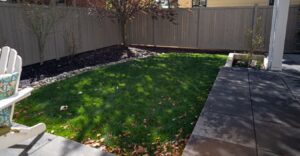A thoughtfully designed garden does more than beautify your property; it becomes an inviting space to relax, entertain, and reconnect with nature. To transform your ordinary garden into an extraordinary one, it is essential to understand the fundamental principles of landscape design in Seattle, Kirkland, Redmond, and surrounding locations. You should follow these principles whether you are starting to design your garden from scratch or reimagining your existing landscape.
Do you also wonder what makes a garden not just attractive but also functional? The answer to this question lies in the principles of professional landscaping design. In this blog, we will explore the seven key principles that guide the creation of a flawless garden landscape design and also address common questions such as “What are the seven principles of landscape design?” and “How much does a landscape design cost?”
Designing with Purpose – Why Principles Matter
A successful home landscape design is not just about placing some plants and installing patios. It’s also about ensuring that every element in the landscape is creating harmony, functionality, and beauty. By incorporating these seven principles of landscape design, you will utilize the full potential during your outdoor garden planning.
At Rich Landscaping, with over four decades of industry experience, we approach each project with purpose. Our team blends traditional and modern garden design concepts to create a personalized landscape that truly reflects your style and makes the design fundamental. These principles are not just theory; they will guide you during every step of your garden transformation.
Quick Overview: The 7 Principles of Landscape Design
Before we go into the details, here’s a quick overview of the seven core principles that make every landscaping layout practical:
| Principle | Why It Matters |
| Unity | Creates a cohesive outdoor design that feels complete and well-rounded. |
| Balance | Brings visual balance to garden design through symmetrical elements. |
| Proportion | Ensures all elements are sized appropriately for the space. |
| Transition | Smoothly connects one area or feature in your garden with another. |
| Rhythm | Adds flow and movement, connecting different elements. |
| Focalization | Draws attention to key areas, such as landscape focal points. |
| Simplicity | Prevents visual clutter and emphasizes essential landscape features. |
Deep Dive into Each Principle:
Let’s now dive into the details of how each design principle works in practice and contributes to making a practical garden design. These ideas help to shape every successful garden from concept to completion.
1. Unity: Creating Harmony in Your Garden
Unity in landscape design means creating a feeling that all elements of your outdoor space belong together. All the elements, from the choice of plants to the landscape material, should work towards a single theme. Whether you’re going for a minimalist look or a classic cottage feel, unity ties it all together.
For example, garden landscape ideas, such as a Japanese Zen garden, follow uniform materials, repeating textures, and deliberate plant selection and placement to create a unified space. Our team at Rich Landscaping helps homeowners in Seattle and Redmond build harmonious outdoor areas that reflect both their personality and property aesthetics.
2. Balance: Visual Stability in Outdoor Spaces
By balance, it doesn’t mean creating perfect symmetry but rather creating an equilibrium. You have the flexibility of choosing between symmetrical and asymmetrical layouts, depending on your personal aesthetic. If you opt for asymmetrical landscape layout ideas, it will allow you to be more creative with your home space, which will reflect your unique personality.
In smaller gardens, balance can be achieved through adding shapes and grouping plants. While planning a larger outdoor garden, you also need to consider trees and water features and strike a balance between them.
3. Proportion: Sizing Elements to Fit the Space
Proportion ensures that all features, from plants to patios, are selected in accordance with the garden’s scale and overall design. Oversized elements can be overwhelming, while too small elements can get lost, among other features. Choosing the right size for these features will greatly affect the aesthetic of your landscape.
Proportion mistakes are very common in landscaping design for the home, such as adding trees that will outgrow their space or using patio furniture that is too bulky. The Rich Landscaping team adheres to the principle of proportion, prioritizing accurate plant selection and placement to create a harmonious landscape.
4. Transition: From One Area to the Next
A well-designed garden should not feel like a collection of separate plants. It should flow naturally. Transition helps your eyes and feet move naturally from one zone of the garden to another. It is one of the most important elements of landscape design when combining hardscape vs. softscape features.
Such a flow can be achieved by adding plants that gradually change in height, using color gradients, or layering textures to create a seamless transition. For instance, the transition of a dining patio to a garden lawn may involve stepping stones accompanied by ornamental grasses. Our team at Rich Landscaping ensures a seamless transition between the garden zones in every project.
5. Rhythm: Repetition That Engages the Eye
Rhythm in landscaping designs means a correct order and engagement. The correct repetition of colors, plants, and materials leads the viewer through the garden. Without rhythm, a space can feel chaotic or disconnected.
A row of flowering plants along the walkway creates a natural visual path. Or how repeating stone types throughout the yard gives continuity. We follow the principle of rhythm, which provides backyard landscape inspiration without repetition.
6. Focalization: Drawing the Eye Where It Matters
An attractive landscape design needs to have a focal point, something that captures attention. This principle is all about leading the viewer’s eye to stand-out features in your garden.
Elements like sculptures, fountains, or a statement tree can serve as the landscape’s focal point. Localization of your garden can also be done through the strategic use of lighting. Landscape layout ideas provided by Rich Landscaping’s team focus on maximizing the impact of each feature.
7. Simplicity: Less Clutter, More Impact
While planning, it’s very easy to overcomplicate a simple design. However, when you stick with simplicity, it ensures clarity and elegance. In landscape gardening design, restraining your urge to add more elements will lead to a more impactful outcome.
Our team follows the principle of minimalism, and instead of overstuffing elements, we help clients select meaningful ones that align with their lives. Simplicity brings out the beauty of each element while supporting functionality.
Planning Ahead – Budgeting and Professional Help
Creating your dream garden begins with thoughtful planning—and that includes your budget. While it’s tempting to jump right into design, understanding the cost factors can help you make smarter, more efficient choices from the start.
At Rich Landscaping, we provide transparent estimates and offer customized recommendations tailored to your specific needs. Depending upon your choice from modern garden design concepts to traditional layouts, our professional landscape planning process ensures that you get the best design without compromising on style or quality.
Hiring a designer at an early stage in your project enables you to budget more effectively and utilize your space more efficiently, thereby minimizing resource waste. Professionals adhere to the principles of landscaping to create a cohesive outdoor design that avoids common mistakes and utilizes every square foot effectively. Whether you’re starting to transform your backyard from scratch or giving your outdoor space a facelift, following expert landscape architecture basics ensures that your vision is designed with precision and beauty.
Bringing It All Together – Your Landscape, Reimagined
The seven principles of landscape design — unity, balance, proportion, transition, rhythm, focalization, and simplicity — form the foundation of any successful garden design. When followed accurately, they create a space that is not only beautiful but also functional and tailored to reflect your style. It’s important to understand how to design a landscape using these principles if you want to transform your backyard space into a personalized haven.
Whether you’re planning a comprehensive landscape design in Kirkland, a garden refresh in Redmond, or an entirely new home landscape design in Seattle, these principles guide you toward lasting beauty. From landscape focal points to smooth transitions and proportional plantings, these elements are crucial for successful outdoor garden planning.
Ready to bring your dream garden to life? Rich Landscaping offers expert services, bringing in decades of experience and innovation. Our team will guide you every step of the way, from plant selection and placement to designing for rhythm and flow. Contact Rich Landscaping at (425) 222-9544 today and take the first step toward your perfect landscaping design for your home.






